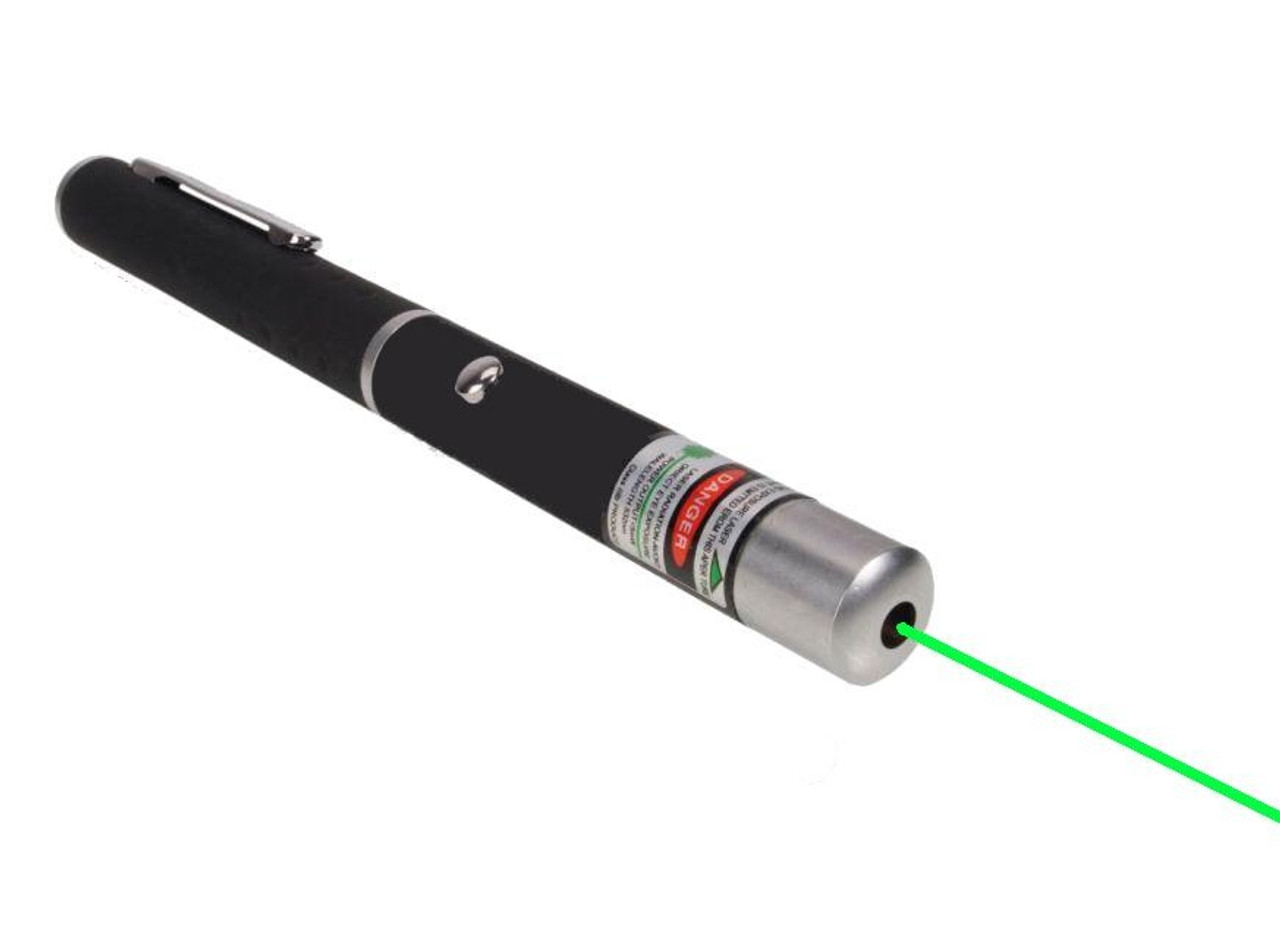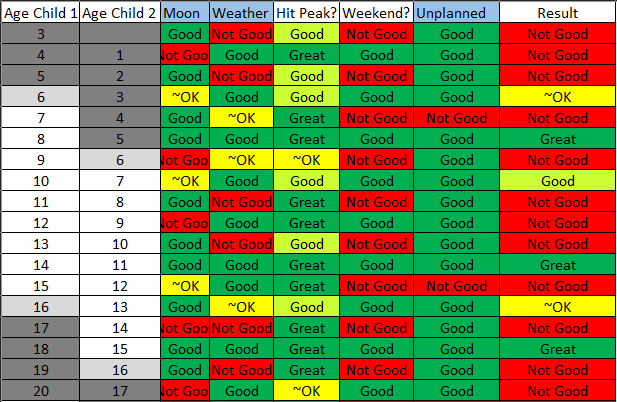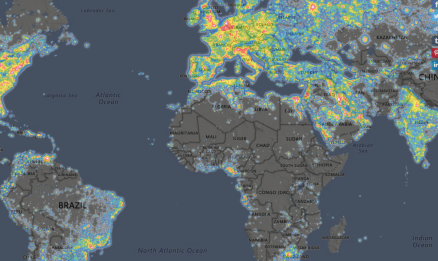This a favorable moon phase this year, so this may be your only chance for many years to see the Perseid meteor shower! Your life could change before the next chance in 2026 – and if you have kids, this is your only chance to share it with them when they are their current ages. Here is how my kids taught me this:
My sons a few years ago, as we planned for that year’s Perseid Meteor trip:
K: Next year the Moon will prevent our trip, but the Moon is perfect this year, it could be an awesome show – maybe like the year we watched by Lake Michigan!
R: Yeah, and the bulldozer we saw there was kinda weird.
K: No, not then. That show was good, but nothing like the Lake Michigan year.
R: But that was a lot of meteors!
K: Yes. It was cool, but not as many meteors as the Lake Michigan year…..
R: But we’ve never seen them over Lake Michigan!
K: Yes, we have. We were out on the sand for hours!
As the discussion continued, I realized that R has never seen a show like the one K remembered. After all, he was under 6 years old that year, and some years the Moon washes them out, or it’s cloudy, or whatever. Even though we prioritize it every year, at 13 years old he had simply not had the chance yet to see a really great Perseid show (though this year looks good – see below!). Yes, he’s seen some pretty good shows, including ones which really impressed him – and that’s valuable in itself (page down to skip the odds and go right to viewing instructions). But it made me wonder how it could be that he hasn’t seen a show like the one his brother was referring to, when we try to go nearly every year?
Time to check some probabilities! It couldn’t quickly get all the information for the past 7 or 10 years, but I could estimate each factor. The Perseids appear for only 1 to ~3 nights each year, I realized how different this is from, say, a Saturn/Jupiter conjunction, which lasts for two months. With two months, you can find a good night, at least sometime, if you want. With only a couple days for the Perseids, the factors have to line up well, or you could miss it. And that’s exactly what happened the last time we had a good Moon phase, in 2021. A 3 day patch of rain moved in and we had to cancel the trip.
Going over these factors (which I’ll do below), I realized how important, and difficult it can be to open the door to the Universe to one’s child. As a parent, I want to share awesome Universe things like this with my kids – and it turns out to be surprisingly hard to do (and sometimes easy!). Hard, in this case, because we only have a few short years before they grow up. As a new parent, years ago, their childhoods stretched out before me, a seemingly near infinite time, maybe because we remember our own childhoods as being “long”. But I was wrong – very wrong. In the blink of an eye the toddler is forever gone, then the child is taking driver’s ed, and soon you are dropping off the young adult at college, and your chance to instill a fascination with our Universe is largely gone forever. Many of us who saw this happen wish we could send a dire warning to our younger selves! Show the child the Universe & our Earth at every chance! Each Sabbat is a fleeting opportunity! Teach them the wonder of our world, critical thinking, and joy! Hear us, & hear your Ancestors, young parents!
Here is this Perseid example which again brought this home to me, this time (of many, now). To see a great Perseids show, the factors include the phase of the Moon, the weather the night of the peak, how close you happen to hit the peak, whether a weekend is close, etc.
The Moon
The Moon is a wonder in and of itself, but a Moon of any phase in the sky is bright enough to wash out many of the meteors so they are not seen. A full Moon wipes out the whole night, a quarter Moon wipes out half the night, etc. Basically the % of the Moon which is illuminated is the % of the night eliminated, with anything over ~60% illuminated effectively killing the whole night (and hence that year’s Perseids) due to the brightness of dusk and dawn. Thus an OK Moon, at some long enough time of the night, happens maybe ~65% of the time. Note also that next year is toast, and that the moon won’t again be as good as this year until 2026.
The Weather
If it’s rainy or even just cloudy, forget it. Here, nights are clear probably ~70% of the time in the summer, but that varies a lot depending on where you are, and a mostly cloudy night won’t work, as you need to see nearly all of the sky (not like, say, a Lunar Eclipse).
The Peak
Here are direct data on the Perseid Meteor Flux. The peak is quite sharp – as you can see, it’s only above 60 meteors/hour for about 24 hours. Because half of that will be daylight, that means we have 1 night, not more, for the best show. A couple nights on either side are still pretty good though (20-50 meteors per hour). We don’t know for certain which night will be the peak (this year, the night of the 11th or 12th looks most likely to be the peak, but if the space dust won’t cooperate, it could be the 10th or 13th. So let’s estimate a 70% chance that you get a great or at least pretty good show if everything else is good. 
Weekend?
A dark location is out the back door for some of us, but most of us probably have to drive a bit, and maybe camp, to get to one with a Bortle class or 4 or lower (lower is better) – use this map. We are going to a Bortle class 2 location this year. So as a working parent, being several hours from home at midnight when I work the next day is tough. How many of us can take a vacation day/camp when we want? Can we get there the one night of the peak? Maybe it’s an 80% chance of being able to make it work?
Unplanned Emergency?
Though not likely, sometimes life happens. Uncle Jimmy’s basement floods and he needs help urgently, or a kid gets pukingly sick (not all that rare!), or the car breaks down on the way there, or you are called into work, or, or…. Let’s say there is a 90% chance nothing derails the Perseids like that.
Odds
Each factor, individually, is not likely to stop you. But in combination, the odds go down quickly. Using the numbers above, 65% X 70% X 70% X 80% X 90% = 23% (that was Moon X Weather X Peak X Weekend X Surprise). Really? Only a ~23% chance of a great Perseids show any given year? Yes, depending on your own situation. Now add the fact that you only have a few years of childhood, and take a look at the hypothetical table below (you have zero influence on the factors in blue). It’s very easy, even if you try to avoid it, to have a 14 year old who hasn’t seen what a Perseid show is like. Add another kid and the window gets even smaller. Plus, after ~13, a child may get Teenager Syndrome (TS), making anything a parent tries to share become “boring”. Our window could indeed be small, maybe only 6 to 8 chances – there is only 1 Perseid shower a year. Hold on, what about other yearly showers? Only the Geminids are nearly as big. Being in December, it’s usually cloudy and always cold here in December. Your situation may be different – Southern Hemisphere Pagans can simply switch these Perseids/Geminids.
The upshot – at least for me, is that whenever there is a good year like this year, to be sure to try.
These meteor showers, like so much about our Earth and Universe, can help us see the wonders around us.
Meteor Showers
Starting August 10th, a very good meteor shower opportunity is happening. This year, unlike most years, the Perseid meteor shower happens to have a very good Moon phase, with the moon setting around 11 pm, giving the rest of the night for good viewing. On any night from about August 10 through the 14th, just go to a dark area, lay down, and watch the sky for a while (see the graph of the peak, above – the night of the 11th or 12th is probably at “0”). If it’s the 11th or 12th, look especially between 11 pm and 3 am, looking generally Northeast (telescopes and binoculars don’t help). I’m sure you’ll see meteors – we lost count somewhere over 100 perseid meteors a few years ago near Lake Michigan, with many being so big that we could actually see them slow down before going out. See the end of this post for more details on observing.
It only takes a little more realization to shift from seeing meteors as the common misnomer of “falling stars” (they certainly aren’t stars, and they aren’t even really falling) to bits of rock dashed against our hurtling atmosphere, like bugs on a windshield*. Some basics – meteors happen when bits of rock, traveling at thousands of miles an hour hit our atmosphere and burn up in the night sky. Meteor showers happen when a larger body – usually an asteroid or comet) has an orbit which is near or intersects the Earth’s orbit. Though the parent body is millions of miles away, bits of it will be strewn along the whole orbit, and these become meteors if they hit the atmosphere, making a meteor shower. Because the parent body orbit will intersect or come close to the Earth’s orbit only at a specific part of the Earth’s orbit, and locations on the Earth’s orbit are what we call days of the year, these meteor showers happen reliably on the same dates every year. I also recommend taking a bright laser pointer to point out constellations.  Green ones are brighter, but night sky purists will use red ones to avoid interfering with night vision. Personally, I’ve found that the extra beam visibility from the green ones is worth the barely detectable effect on night vision, especially if the sky is not extremely dark. If you order now, you might be able to pick one which arrives on time. In any case, finding a dark place is important. Plan out a place to go where you can lay on a blanket, maybe talk with loved ones and point out constellations, and take time to watch. This site shows a very helpful map of light levels. Zooming in and clicking on the candidate location pops up the data – any place with a ratio of about 1 or less is very good.
Green ones are brighter, but night sky purists will use red ones to avoid interfering with night vision. Personally, I’ve found that the extra beam visibility from the green ones is worth the barely detectable effect on night vision, especially if the sky is not extremely dark. If you order now, you might be able to pick one which arrives on time. In any case, finding a dark place is important. Plan out a place to go where you can lay on a blanket, maybe talk with loved ones and point out constellations, and take time to watch. This site shows a very helpful map of light levels. Zooming in and clicking on the candidate location pops up the data – any place with a ratio of about 1 or less is very good.
The Best One?
Of the meteor showers available, the Perseids are single best shower for those of us in the Northern Hemisphere. There are many reasons for this.
First, and perhaps most obvious, is the number of meteors visible. For instance, the Aurigid meteor shower on September 1st only delivers around 5 meteors an hour, which is less than the background “normal” rate of around 10 meteors an hour (over the whole sky with very dark conditions). So you’ll see nearly as many meteors on just any night, and so it’s not all that big a deal to make it out to see the Aurigid meteor shower. This rate of meteors is known as the Zenith Hour Rate (ZHR). “Hour Rate” is clear, but why “Zenith”?
Zenith – the zenith is the location straight up in the sky (directly overhead). Because the meteors in a shower are from bits of rock which are in orbit around the Sun, the Earth’s orbit intersects this orbit at a certain location, at a certain angle. This means that there is one spot in the sky which “looks” along the orbit of the meteors, essentially looking head on into the meteor stream, where the meteor particles are moving at thousands of miles per hour. This spot in the sky is called the “radiant point” or simply the “radiant”. In practice, it means that all the meteors appear to come from this point (see the image at the top of this post – the radiant is near the center top of the sky in this photo). When the radiant is below the horizon, Many meteor will be on the other side of the Earth, and hence not visible*. The maximum number of meteors will be when the radiant happens to be exactly at the zenith (because the maximum area is available for viewing). The ZNR is the calculated number of meteors one would see in a very dark area (darker than you are likely to be at) with the radiant exactly at the zenith (which almost never happens). Thus, the ZHR is a maximum, not a promise that you’ll see that many. Most meteor showers have ZHRs of 50 or less. Only three are above that – the Quadrantids (January 3rd, 120 ZHR, but these meteors are faint), the Perseids (August 13, 150 ZHR) and the Geminids (December 14, 120 ZHR).
*When the radiant is just below the horizon, most meteors will appear to be going “up”. This is what makes it most clear that they aren’t “falling”, and that there really is no such thing as “up” It is one of the most effective ways to shake our flat Earth, up/down illusion.
A second factor is the number of hours of darkness. Near Litha, in some areas, one might have to stay up very late to get dark skies, or fully dark skies might not happen at all. For the Northern Hemisphere, none of these three showers are close to the Summer Solstice, though the Geminids and Quadrantids are close to the Summer Solstice in the Southern Hemisphere.
The third factor is the weather/temperature. For those of us in many areas of the Norther Hemisphere (I’m in Michigan), laying outside for hours in December or January takes many more layers of insulation than the same thing in August. This makes the Perseids the most accessible and strongest meteor shower for those of us in the North. I’ve found this to be especially true with kids, who often won’t last hours laying down in the snow in sub zero temperatures. However, I do get out to see the Geminids, even here – and they are no doubt a great show for those in the Southern Hemisphere.
A Sacred Event
For me, the Perseids and Geminids are anticipated dates every year – dates which, like our Sabbats, are chosen by orbits and Earth as special days – days that would be still be different from other days even if no one was noticing. It reminds me of the quote Reality is that which, when you stop believing in it, doesn’t go away,” by Philip K. Dick. Our holidays don’t go away, because they are based on reality. I have to wonder if meteor showers are noticed by non-human animals. Nearly anything with eyes can see these meteors – especially the rare, giant fireballs which cast rapidly moving shadows. I wonder if our ancient Ancestors noticed these dates. I have to guess that some probably did, but I don’t know of any stone circle or other evidence of it. If you have clear skies on the 11th, consider celebrating as my family does – by seeing these wonders, just as our Ancestors have seen them for many thousands of years. Do you have a chance to share this sacred moment with a child?
This can be a lot harder than one might think.
Observing:
The morning of August 12th is the peak of the Perseid meteor shower this year, and the peak is rather narrow. Plus, we don’t know exactly when we’ll hit bands of debris, and get the best shows, which are possible on the 11th, 10th and (less likely) the12th. The year also shifts a half a day or so every year due to the leap day (because our year is 365.26 days long). Stardate recommends how to get the best viewing:
Get away from the glow of city lights. Try especially to keep the Northern half of the sky dark (for instance, if you are near a city, it’s better to go to the North of the city than the South of it). Perseid meteors will appear to “rain” into the atmosphere from the constellation Perseus, which rises in the northeast around 11 p.m. in mid-August.
After you’ve escaped the city glow, find a dark, secluded spot where oncoming car headlights will not periodically ruin your sensitive night vision. Look for state or city parks or other safe, dark sites.
Once you have settled at your observing spot, lie back or position yourself so the horizon appears at the edge of your peripheral vision, with the stars and sky filling your field of view. Simply watch the sky. Groups may have different people looking more at different areas of the sky. Relax and let your gaze wander. Meteors will instantly grab your attention as they streak by.
A good Perseids show (with a good Moon position, assuming good weather) happens every few years or so. This is an updated version for the 2021 show. The last good Perseids show was in 2020, and the next is in 2023.
Starstuff, Contemplating by Jon Cleland Host
We are assemblages of ancient atoms forged in stars – atoms organized by history to the point of consciousness, now able to contemplate this sacred Universe of which we are a tiny, but wondrous, part.

Dr. Jon Cleland Host is a scientist who earned his PhD in materials science at Northwestern University & has conducted research at Hemlock Semiconductor and Dow Corning since 1997. He holds eight patents and has authored over three dozen internal scientific papers and eleven papers for peer-reviewed scientific journals, including the journal Nature. He has taught classes on biology, math, chemistry, physics and general science at Delta College and Saginaw Valley State University. Jon grew up near Pontiac, and has been building a reality-based spirituality for over 30 years, first as a Catholic and now as a Unitarian Universalist, including collaborating with Michael Dowd and Connie Barlow to spread the awe and wonder of the Great Story of our Universe (see www.thegreatstory.org, and the blog at evolutionarytimes.org). Jon and his wife have four sons, whom they embrace within a Universe-centered, Pagan, family spirituality. He currently moderates the yahoo group Naturalistic Paganism.
Heather is a parent and a scientist raising her four children to explore the world through scientific understanding and with spiritual appreciation of the Universe. She has a Master of Science degree in Physics from Michigan State University, a Bachelor of Science degree in Aerospace Engineering from the University of Michigan, and a Bachelor of the Arts degree in English Literature, also from the University of Michigan. She teaches physics as an adjunct instructor at Delta College, runs the Math Mania program at a local elementary school, has worked at Dow Corning as an engineer and at NASA as an intern, and she has led science outreach workshops for K-12 students through joint programs between NASA and the University of Michigan. She is a naturalistic non-theist, whose faith has been shaped by her childhood within the Episcopal Church, her adult membership in the Unitarian Universalist church, and through Buddhist meditation. She has a passion for bringing science and spirituality to everyone in a fun way, both for her own family and for the wider community of the Earth. She is a co-author with Jon Cleland-Host of Elemental Birthdays: How to Bring Science into Every Party.
 Naturalistic Paganism
Naturalistic Paganism





Jon,
I recently saw your YouTube video on the humanism of Neil Peart and his love for nature. Can you point me to any more resources that describe Neil’s philosophy? I’ve been a Rush fan for 40 years!
Thank you,
Steven Lentz
Pingback: Happy Summer Thermstice/Lammas! | Naturalistic Paganism